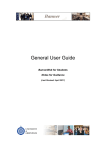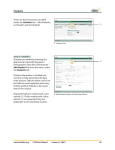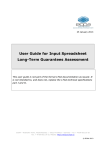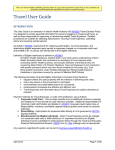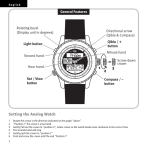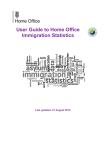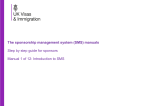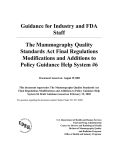Download User Guide to the Home Office Migrant Journey
Transcript
User Guide to the Home Office Migrant Journey Last updated: 18 February 2015 Contents 1 Introduction ……………………………………………………………………………..3 2 Glossary of terms ……………………………………………………………………...5 3 Conventions used in Migrant Journey ……………………………………………..8 4 Methodology …………………………………………………………………………...10 5 Other sources of information on immigration and migration ………………...15 6 List of tables ……………………………………………………………………….…..16 2 1 Introduction This ‘User Guide’ to the Home Office Migrant Journey is designed to be a useful reference guide with explanatory notes on the issues and classifications which are key to the production and presentation of the Home Office’s Migrant Journey. Statistics covered The findings presented in the Migrant Journey are based on administrative data for migrants granted visas in the main six entry clearance routes to the UK: family; skilled work (with a potential path to settlement); temporary work (not leading to settlement); study; visit (for those from non-European Economic Area (EEA) countries who are required to hold a visit visa); and dependants joining or accompanying. Purpose Migrant Journey provides evidence on the behaviour of migrants and is based on UK Visas and Immigration (UKVI) administrative data sources. The purpose of the Migrant Journey is: to inform understanding of the processes that migrants go through when they decide to stay in the UK or switch their status; to help inform users (including government, Parliament, the media and the wider public); and to support the development and monitoring of policy on settlement of migrants in the UK and permanent and temporary migration routes. The current system of immigration control is based on the Immigration Act 1971, which came into force on 1 January 1973, and subsequent amendments to the law. Policy and operational changes, as well as overall factors which influence the levels of immigration, such as the economic climate, can affect the figures. The availability and allocation of resources within the Home Office can affect the number of decisions made. Further information on the work of the Home Office can be found in its annual report and in publications referred to in the Other sources of information on immigration and migration section of this User Guide. Where are the latest published statistics? The latest Migrant Journey, including data tables and commentary, can be found at: https://www.gov.uk/government/statistics/migrant-journey-fifth-report The fourth Migrant Journey report, including data tables and commentary, can be found at: https://www.gov.uk/government/publications/migrant-journey-fourth-report/migrant-journeyfourth-report The third Migrant Journey report, including data tables and commentary, can be found at: https://www.gov.uk/government/publications/migrant-journey-third-report For more information see the ‘Migrant Journey: Second Report’: https://www.gov.uk/government/publications/migrant-journey-research-report-57 or ‘Migrant Journey: First Report’: https://www.gov.uk/government/publications/the-migrant-journey-research-report-43. 3 Feedback and enquiries We welcome feedback on the Migrant Journey, which can be provided by email or in writing, or via the Migration Statistics User Forum: Email: [email protected]. Migration Statistics User Forum: https://www.jiscmail.ac.uk/cgi-bin/wa.exe?SUBED1=MIGRATION-STATS. Alternatively, write to: The Editor, Immigration Statistics Migration Statistics Home Office Statistics 17th Floor, Lunar House, 40 Wellesley Road Croydon CR9 2BY. Press enquiries should be made to: Home Office Press Office Peel Building 2 Marsham Street London SW1P 4DF Tel: 020 7035 3535 4 2 Glossary of terms This glossary accompanies the Migrant Journey release. It is intended to give an overview of the terms, rather than a full technical description. If there are terms in the Migrant Journey release that you would like to be explained in this glossary, please contact: [email protected]. Acronyms CID Case Information Database LTR Leave to Remain CRS Central Reference System NS National Statistic HSMP Highly Skilled Migrant Programme ONS Office for National Statistics ILR Indefinite Leave to Remain PBS Points-based system UKVI UK Visas and Immigration Terms Within an explanation of a term, words in bold are explained elsewhere in the glossary. An asylum applicant is a person who either: (a) makes a request to be recognised as a refugee under the Geneva Convention on the basis that it would be contrary to the UK's obligations under the Geneva Convention for him to be removed from or required to leave the UK, or (b) otherwise makes a request for international protection. EEA Family Permit: A family permit is issued overseas to direct and extended family members of an EEA national who is in, or intends to come to, the UK to exercise free movement rights. Under the Immigration (EEA) Regulations 2006, Swiss nationals are included in the definition of EEA nationals. Family members of Swiss nationals have the same free movement rights as family members of EEA nationals. Entry clearance takes the form of a sticker, also called a vignette, which is placed in a person’s travel document. Entry clearance can be called a visa (for visa nationals), an entry certificate (for non-visa nationals), or a family permit for family members of EEA nationals. These documents are to be taken as evidence of the holder’s eligibility to travel to the UK, and accordingly accepted as “entry clearances” within the meaning of the Immigration Act 1971. The term “visa” maybe used as a generic term for all types of entry clearance but in Immigration Statistics it does not refer to an entry certificate. An entry clearance visa is a document permitting the bearer to travel to the UK and leave to enter from the date of issue. It is activated upon passing through UK immigration control. There are three categories of visa: temporary, leading to settlement and settlement. Visas are required by nationals or citizens of the countries and territorial entities listed in Appendix 1 of the Immigration Rules known as ‘visa nationals’. Nationals of countries not on this list are known as ‘non-visa nationals’. A non-visa national does not need a visa to come to the UK for less than six months, unless it is a requirement of the immigration category under which they are entering. A non-visa national coming to the UK for more than six months will need a visa.. The European Economic Area (EEA) consists of the 28 countries of the European Union, plus Iceland, Liechtenstein and Norway. Nationals of the EEA and Switzerland have rights of free movement within the UK. The European Union (EU) consists of 28 countries: Austria, Belgium, Bulgaria, Croatia, Cyprus, the Czech Republic, Denmark, Estonia, Finland, France, Germany, Greece, Hungary, 5 Italy, Latvia, Lithuania, Luxembourg, Malta, Netherlands, Poland, Portugal, Republic of Ireland, Romania, Slovakia, Slovenia, Spain, Sweden and the UK. Croatia joined the EU28 on 1st July 2013 Family route is for those seeking to enter or remain in the UK on the basis of their family life with a person who is a British Citizen, is settled in the UK, or is in the UK with limited leave as a refugee or person granted humanitarian protection (and the applicant cannot seek leave to enter or remain in the UK as their family member under Part 11 of the Immigration Rules). Family Life (10-year) route: Partners and parents who apply in the UK and are granted leave to remain on a 10-year route to settlement on the basis of their family life where the relevant provisions in Appendix FM to the Immigration Rules (including EX.1) apply. Indefinite leave to remain is a grant of settlement (after entry) to a non-EEA national. Leave to remain is permission to stay in the UK either temporarily (limited leave to remain) or permanently (indefinite leave to remain). In this release, an extension of leave to remain is known as ‘extension of stay’ and indefinite leave to remain is known as ‘settlement’’. Official Statistics are data which are collected for the purpose of supporting government business. In the Immigration Statistics release, any data described as ‘Official Statistics’ are drawn from the Home Office’s administrative systems and have not necessarily been subject to the same detailed verification processes as those badged as National Statistics (NS). For example such figures may include: (a) data produced internally for operational management purposes in the first instance, rather than produced solely for the published statistics; (b) data added to the Home Office’s migration statistics publications after these were last designated as National Statistics and prior to re-designation as NS by the UK Statistics Authority. Under the Statistics and Registration Service Act 2007 framework, the designation of new statistics as ‘National Statistics’ is undertaken by the UK Statistics Authority. Hence (b) are therefore described as Official Statistics rather than National Statistics. The UK Statistics Authority has designated the statistics within Immigration Statistics as National Statistics, in accordance with the Statistics and Registration Service Act 2007 and signifying compliance with the Code of Practice for Official Statistics. In previous versions of this User Guide, Official Statistics have also been referred to as ‘management information’. The Points-based system (PBS) is the main route for non-EEA nationals working and studying in the UK. It consists of five 'tiers'. See the definitions for the individual tiers, Tier 1, Tier 2, Tier 3, Tier 4 and Tier 5 for further information. Private Life: grant of leave to remain in the UK because the person has established a private life in the UK. In order to be eligible to apply for leave to remain on the basis of private life in the UK, the applicant must have resided continuously in the UK for at least 20 years or be able to demonstrate that there are very significant obstacles to their integration in the country to which they would return. For young people aged between 18 and 24 the applicant must have resided continuously in the UK for at least half of their life, and for children aged under 18 the applicant must have resided continuously in the UK for at least 7 years and show that it would not be reasonable to expect them to leave the UK. Applicants can only apply for this route from within the UK. Refugee is defined, by the 1951 United Nations Convention relating to the Status of Refugees and 1967 Protocol (the ‘Refugee Convention’), as being a person who, owing to a well-founded fear of being persecuted for reasons of race, religion, nationality, membership of a particular social group or political opinion, is outside the country of their nationality or habitual residence, where stateless and who is unable or, owing to such a fear, is unwilling to avail themselves of the protection of that country. Recognition of refugee status by the UK is a pre-requisite to the grant of asylum in the country. 6 Settlement is a grant of indefinite leave to enter (on arrival) or indefinite leave to remain (after entry) to a non-EEA national. Skilled work (with a potential path to settlement) relates to work categories that were eligible to apply for settlement after a specified time period. These were mainly routes equivalent to PBS Tiers 1 and 2, and some unskilled routes e.g. domestic workers. Students are non-EEA nationals travelling to the UK primarily or solely for the purpose of study. The student visitor category provides for those people who wish to come to the UK as a visitor and undertake a short period of study which will be completed within the period of their leave (maximum six months unless applying under the concession for English language courses – 11 months). Short-term students (i.e. those studying on courses of six months’ duration or less) who do not intend to work part-time or undertake a paid or unpaid work placement as part of their course can also apply within this category. Temporary work (not leading to settlement) mainly relates to routes equivalent to PBS Tier 5. Tier 1 of the points-based system: For high value individuals who will contribute to growth and productivity. Tier 2 of the points-based system: For skilled workers from outside the EEA with a skilled job offer to fill gaps in the UK labour force. Tier 3 of the points-based system: For limited numbers of low-skilled workers needed to fill specific temporary labour shortages (this has never been implemented). Tier 4 of the points-based system: Students. Tier 5 of the points-based system: Youth mobility and temporary workers: people allowed to work in the UK for a limited period of time to satisfy primarily non-economic objectives. Visa: see Entry clearance. A visa national is: a national of a country listed as requiring a visa for any type of entry to the UK; a stateless person; a holder of a non-national travel document unless issued by the UK; or a holder of a passport issued by an authority that is not recognised in the UK. Visa nationals must obtain entry clearance before travelling to the UK, except in certain circumstances, unless they are returning residents or those with permission to stay who are returning after a temporary absence. 7 3 Conventions used in Migrant Journey Rounding Data for the forward-view analysis are rounded to the nearest 100 and all supplementary tables are provided unrounded. This is to promote transparency and allow users to exploit the data further. However, caution should be taken when comparing small differences between time periods; while care is taken in collecting and collating all the information obtained, the figures are subject to the inaccuracies inherent in any large recording system and are not necessarily accurate to the last digit. There are a range of different types of errors possible, such as those resulting from recording errors or misclassifications. Percentages are rounded to the nearest per cent using the round-half-away-from-zero method. The round-half-away-from-zero method has been used, so that in the borderline case where the fraction of the percentage is exactly 0.5, the rounded figure is equal to y + 0.5 if y is positive, and y - 0.5 if y is negative. For example, 23.5 per cent is rounded to 24 per cent, and -23.5 per cent is rounded to -24 per cent. Where data are rounded, they may not sum to the totals shown, or, in the case of percentages, to 100 per cent, because they have been rounded independently. Use of symbols The following symbols have been used in the tables: : - Not applicable. Nil. Using the data: filtering of tables Several of the tables accompanying the Migrant Journey report include filters (buttons in the cells at the top of columns) to allow users to select which part of the data they wish to view. Many of the tables will already be filtered when the file is first downloaded. To use the filters click on the button and select the item you want to see from the list presented. The icon within the button changes colour and/or shape to indicate a filter has been selected for that column. To undo or change the selection click on the button again and select another item from the list presented. More than one column can be filtered at the same time. The colour and form of the icon shown in the filter button may differ according to the package being used to view the table. Filtering may not be possible when viewed on some mobile devices. Revisions to data The data contained in the Migrant Journey are revised every year. It is not possible to evaluate whether any future revisions will be upward or downward; but the reasons for revisions are likely to include: 8 late reporting of cases – a small proportion of cases are not included when the statistics are produced; and the results of data-cleansing exercises, such as data identified that cannot be included when the statistics are calculated because of missing or invalid values, or the identification of duplicates in the data. Factors affecting the statistics Immigration Rules, which are laid before Parliament by the Home Secretary, govern the entry and refusal of entry of passengers into the UK, the conditions of stay in the UK, the variation of such conditions following entry, settlement and the deportation or removal of individuals. Current Immigration Rules are stated in ‘Statement of Changes in Immigration Rules’ HC 395, which took effect from 1 October 1994. This consolidated previous rule changes, although there have been changes to the rules since 1994. Some of these changes have affected the statistics and the most important changes are given in the ‘Policy and Legislative Changes Timeline’ published alongside the Migration Journey report. Strengths, limitations and data quality Below are some general strengths and limitations of the Migrant Journey. Strengths of the data provided: Very detailed information based on administrative sources providing exact counts by detailed nationality. Possible to see how changes to the UK’s immigration control system have direct impacts on the numbers, which are used to directly monitor that system. Limitations of the data provided: Home Office data are not as suitable as ONS data for understanding overall trends in all UK immigration, emigration and net migration. Home Office data generally relate to those subject to immigration control, rather than all immigration including by UK and other EU nationals; therefore for analysis of total immigration ONS data are more appropriate (http://www.ons.gov.uk/ons/taxonomy/index.html?nscl=Migration). Home Office data do not provide information on emigration. Official Statistics and National Statistics Official Statistics are data which are collected for the purpose of supporting government business and are drawn from the Home Office’s administrative systems. They have not necessarily been subject to the same detailed verification processes as those badged as National Statistics (NS). The data contained in the Migrant Journey are Official Statistics. Information about the policy context A summary of the UK Government’s immigration and asylum policy, plans and measures introduced has been published by the House of Commons library. Melanie Gower 29 July 2013 | Standard notes SN05829 Immigration and asylum policy: Government plans and progress made – Commons Library Standard Note http://www.parliament.uk/briefing-papers/SN05829 Further information about UK Government policy, including links to the Home Office website, is given in the ‘Other sources of information’ section. 9 4 Methodology Data source The statistics were extracted from two of the Home Office’s databases. Case Information Database (CID) – data on extensions of stay within the UK. CID was introduced in 2000 as the Asylum Case Information Database (ACID). It was then expanded in 2002 to cover non-asylum extensions of stay, settlement and British citizenship casework. Finally, systems dealing with port and enforcement casework were added in 2003. No records of migrants issued an extension of stay in the UK before 2000 were transferred to the CID. This means that the database did not contain complete case histories until 2004, and hence this is the earliest point for which the analysis in this report could be undertaken. Central Reference System (CRS) – data on grants of entry clearance (visas issued). CRS was introduced in 2002 and is used to collect details of entry clearance applications in diplomatic missions abroad. Data from the two databases were combined to produce a record of migrants’ activity in the UK immigration system from the initial point of entry until they were granted settlement or their last record of leave expired. Migrant Journey statistics are produced by UK Visas and Immigration within the Home Office. The Migration Statistics team within the Home Office, who do not have access to the CRS database, prepare the tables for publication. Methods The Migrant Journey report includes two types of analyses: a forward-view analysis; and a backward-view analysis. Forward-view analysis The forward-view analysis looks at the cohort of migrants granted entry clearance in 2004, 2005, 2006, 2007 and 2008. The analysis maps migrants’ immigration statuses at the end of each year to identify whether they had valid permission to remain in the UK or whether they had changed their category of leave. It should be noted that a valid visa does not confirm that a migrant is still in the UK at that point, as it is possible that they may have left prior to the visa expiring. Where a migrant has an expired visa there are four possible outcomes: the migrant has left the UK; the migrant is still in the UK (as an overstayer); the migrant has made an application for further leave to remain (LTR) that has not yet been processed, although for the period covered here the number in this final category will be small; or the migrant never travelled to the UK (the visa was not used). Backward-view analysis The backward-view analysis reports on migrants granted settlement in each of the four years (2009, 2010, 2011, 2012 and 2013), tracing their records back through the immigration system to identify their initial entry clearance route and year of entry. The data provide 10 information on migrants from the point they received clearance to enter the UK, until they leave the immigration system or are granted settlement. Migration to the UK via non-visit visa routes is mainly managed through the points-based system (PBS) – see Glossary of Terms. Background and changes in legislation and policy affecting the statistics The points-based system (PBS) was introduced in 2008 and consists of five ‘tiers’. Three of these (Tiers 1, 2 and 5) relate to permission to work. Tier 1 provides a route for high-value workers; its phased implementation took place between February 2008 and June 2008, replacing the Highly Skilled Migrant Programme (HSMP), which also led to settlement. Subsequent changes are: Tier 1 General route was closed to new “out-of-country” entry clearance visa applicants from 23 December 2010 and to those applying inside the UK to switch from most categories from 6 April 2011; a new Tier 1 route (Exceptional Talent) was introduced from 9 August 2011; Tier 1 Post-study route was closed to new applicants from 6 April 2012; a new Tier 1 Graduate entrepreneur category was introduced from 6 April 2012; continuing routes for Tier 1 are: Entrepreneurs; Investors; Graduate entrepreneurs; and Exceptional talent. Tier 2 and Tier 5 were implemented in November 2008. Tier 2 replaced the Work Permit scheme and provides a route for skilled non-European Economic Area (EEA) nationals with sponsorship from a UK employer to come to live and work in the UK. The Work Permit scheme granted skilled migrants leave to remain (LTR) in the UK in order to work in a skilled occupation. Tier 5 is for temporary workers and youth mobility, providing a route for those coming to the UK for primarily non-economic reasons. The additional tier (Tier 3) relates to unskilled workers and has never been implemented. From 6 April 2012, Tier 2 skilled workers are allowed to stay in the UK for a maximum of six years if they are not granted permission to stay in the UK permanently. After six years they will have to depart the UK or switch into a different category. Tier 2 policy guidance http://www.ukba.homeoffice.gov.uk/sitecontent/applicationforms/pbs/tier2-guidance.pdf states that those who depart the UK will not normally be able to reapply to return to the UK under Tier 2 for 12 months. Tier 4 was implemented in March 2009 and provides a route for students to study with an approved education provider. Subsequent changes include a limit to the overall time that can be spent on a student visa. Further details are available from: http://www.ukba.homeoffice.gov.uk/visas-immigration/studying/adultstudents/how-long/ Student visas statement of intent and transitional arrangements http://www.ukba.homeoffice.gov.uk/sitecontent/documents/news/sop4.pdf New student policy summary http://www.ukba.homeoffice.gov.uk/sitecontent/documents/news/summarystudent-policy.pdf The Tier 4 Doctorate Extension was introduced on 6 April 2013. Other non-visit visa categories outside of the PBS allow migrants to come to the UK for family reunion (through marriage and migration of dependent children) or to obtain settlement (indefinite LTR). 11 In this analysis the ‘family route’ is made up of those coming to join or accompany family members who are British citizens or settled people. This includes fiancé (e)s, proposed civil partners, spouses, civil partners, or unmarried or same-sex partners, children and elderly relatives. Data from 2012, also include those seeking to enter or remain in the UK on the basis of their family life with a person with limited leave as a refugee or person granted humanitarian protection (and the applicant cannot seek leave to enter or remain in the UK as their family member under Part 11 of the Immigration Rules). Following a consultation on family migration, a number of changes to the Immigration Rules came into effect on 9 July 2012. The changes included: introduction of a maintenance and accommodation threshold of £18,600 (with higher levels for also sponsoring non-EEA dependent children); extending from two years to five years the minimum probationary period before nonEEA spouses and partners can apply for settlement in the UK; abolishing immediate settlement for the migrant spouses and partner where a couple have been living together overseas for at least four years, and requiring them to complete a five-year probationary period; introduction of a genuineness test for relationships; and allowing adult and elderly dependants to settle in the UK only where they can demonstrate that, as a result of age, illness or disability, they require a level of longterm personal care that can only be provided by a relative in the UK, and requiring them to apply from overseas rather than switch in the UK from another category, for example as a visitor. The new Immigration Rules also balance the rights of the individual with the public interest in controlling immigration and protecting the public, with requirements defining the basis on which a person can enter or remain in the UK on the basis of their family or private life. It is not possible to separately identify migrants issued a visa under the family Immigration Rules implemented on 9 July 2012. The asylum route is another way that migrants can enter the UK and achieve settlement. The number of settlement grants issued to migrants granted asylum fell from 67,810 in 2005 to 30,655 in 2006. By the end of 2009, 3,110 migrants in the asylum route had been granted settlement. This decrease is partly due to changes to asylum policy in 2005. Prior to August 2005, those granted asylum were immediately entitled settlement. Migrants who are granted asylum after that date are entitled to receive five years’ temporary permission to stay after which they can apply for settlement. However, a large part of the decrease in asylum cases leading to settlement is due to the fall in numbers of people seeking and being granted asylum. In 2011 the number of applications for asylum in the UK was under 20,000, compared with a peak of 84,000 in 2002. The migrant-journey analysis excludes asylum seekers without an initial visa record from the cohort in order to focus on regular migrants who are managed through the UK’s immigration system. Data matching Data from the two databases used to produce the Migrant Journey were combined by a datamatching exercise. Criteria were defined to ensure that migrants’ details were accurately matched, and the results of the data-matching exercise were rigorously checked for coherence and consistency. A data-cleansing exercise excluded migrants whose records contained a visa record without an issue date and/or a last recorded grant of LTR without an expiry date. The criteria used to match data from the two databases were passport number, name, date of birth and nationality. Five matching levels were created – the exercise attempted to match migrants at the highest level possible (level one). Only negative matches at level one led to an attempt to match a case at level two. The first level matched migrants’ passport number, nationality and year of birth; 75 per cent of all positive matches were achieved at this level. The second level matched passport number and nationality (1% of all 12 matches); and the third level (name, date of birth and nationality) made up a further 21 per cent of all positive matches. Records of migrants who could not be matched at the five levels were included in the backward-view analysis of migrants granted settlement from 2009, but were excluded from the forward-view analysis of migrants granted a visa from 2004. The process worked on the assumption that in-country grants of an extension of stay and settlement are preceded by an issue of an out-of-country entry clearance visa. It should be noted, however, that there are legitimate reasons why a migrant may not have a visa record on the out-of-country database. Migrants who came to the UK before the existence of out-ofcountry databases or children born to parents with temporary permission to stay in the UK may not have a visa record. Individuals who entered the UK as illegal immigrants or asylum seekers would not be identified on out-of-country databases. However, they may be identified on the in-country database if they applied for permission to stay after they had entered the UK. Migrants not matched to an initial visa record were included in the analysis of the cohort granted settlement in 2009. This analysis traced migrants back through the immigration system until their earliest record (in some cases this was as early as 2000), and acknowledges that there are several reasons (as described in the previous paragraph) why a migrant may not have an initial visa record. Analysis of the cohort of migrants granted a visa in 2004 identified migrants’ immigration statuses at the end of each year over a five-year period. Therefore this analysis could not include cases without a visa record (non-matched cases) or those granted a visa prior to 2004. In order to facilitate analysis, the more detailed list of visa categories was grouped to present the major non-visit routes covered by the Immigration Rules. For the purposes of the Migrant Journey report, each migrant’s journey through the immigration system was tracked from the original visa category granted to them, through all the grants of entry clearance visas or extensions of stay and settlement records on the Home Office databases. The data collected for each migrant consisted of the type of leave granted (‘route’), the grant issue date and the expiry date. These details were put in chronological order using the grant issue date, with the type of leave granted (usually a visa) denoting the initial route of entry. This chronological ordering showed when and how each individual entered the immigration system, and the date of expiry of their last recorded extension or change of leave. There are a number of visas which act as a catch-all for dependants – these are included within ‘Dependants joining/accompanying’ visa endorsements. In previous Migrant Journey reports these endorsements were mapped according to the immigration route of the next leave granted in the journey. Where there was no grant of further leave in the journey, a default mapping of ‘Family’ was applied. To improve the alignment of the migrant-journey analysis with other immigration publications, these endorsements are now shown as a separate category ‘dependant joining or accompanying’ rather than mapped according to the immigration route of the next grant of leave in the journey. If the elapsed time between consecutive visas within the migrant journey is longer than 12 months, the journey is separated into two separate journeys. However, this is limited to those journeys that are person centric (i.e. CRS records have been matched to CID). In other words, it does not apply to visa-only journeys as this would require matching of the CRS database to itself. The vast majority of applications for visit visas are for those that do not allow ‘in-country’ extensions of leave. People who have gained settlement after five years would have subsequently applied for a visa that provides a path to settlement, for example, migrants who arrive on a visit visa but subsequently claim asylum or those who are dependants (including parents and grandparents). Following rule changes implemented on 9 July 2012, adult 13 dependent relatives who wish to join a settled person or a British citizen must now apply from outside the UK. Dependants joining or accompanying are dependants who have been issued a visa on the basis of their relationship with another migrant, who is not a settled person or British citizen and may have been issued a visa for any reason (e.g. work, study, family, etc). Dependants are allocated an entry clearance category according to the circumstances of their application. Please see the user guide for further information on the entry clearance rules for dependants. Within the Points-based system (PBS), a child or partner will be recorded as a dependant under the tier of the main applicant, unless he/she has applied for and been granted a PBS visa in their own right, when they will be included as a main applicant. Outside of the PBS, many visas for dependants are specific to the visa for the main applicant. However, there are a number of visas which act as a catch-all for dependants who have been issued a visa on the basis of their relationship with another migrant, who is not a settled person or British citizen – these are included within ‘Dependants joining/accompanying’ and may have been issued a visa for any reason (e.g. work, study, family, etc). 14 5 Other sources of information on immigration and migration Research Reports on immigration control are published by Home Office Science as reports and occasional papers: https://www.gov.uk/government/organisations/home-office/series/migration-research-andanalysis. Immigration Statistics releases, including data tables and commentary, can be found at: https://www.gov.uk/government/organisations/home-office/series/immigration-statisticsquarterly-release. A short statistical article on ‘Extensions of stay by previous category’, https://www.gov.uk/government/publications/extensions-of-stay-by-previous-category, has also been published alongside the Immigration Statistics April-June 2013 release to provide further detailed information. The dates of future editions of Immigration Statistics are pre-announced and can be found via the UK National Statistics Publication Hub: http://www.statistics.gov.uk/hub/index.html. Information on how the Home Office complies with the Code of Practice for Official Statistics is available at: https://www.gov.uk/government/organisations/homeoffice/about/statistics#official-statistics. 15 6 List of tables This section provides a list of the tables published in the Migrant Journey. Table number MJ_01 MJ_02 MJ_03 MJ_04 MJ_05 MJ_06 MJ_07 Title End-of-year immigration status or category of main applicants and dependants issued a visa in the family route by country of nationality and cohort. End-of-year immigration status or category of main applicants and dependants issued a visa in the skilled work (with a potential path to settlement) route by country of nationality and cohort. End-of-year immigration status or category of main applicants and dependants issued a visa in the work (not leading to settlement) route by country of nationality and cohort. End-of-year immigration status or category of main applicants and dependants issued a visa in the study route by country of nationality and cohort. End-of-year immigration status or category of main applicants and dependants issued a visa in the visit route by country of nationality and cohort. End-of-year immigration status or category of dependants issued a visa in the dependants joining or accompanying route by country of nationality and cohort. Migrants granted settlement by year of grant, country of nationality, initial route and year visa issued. 16
















